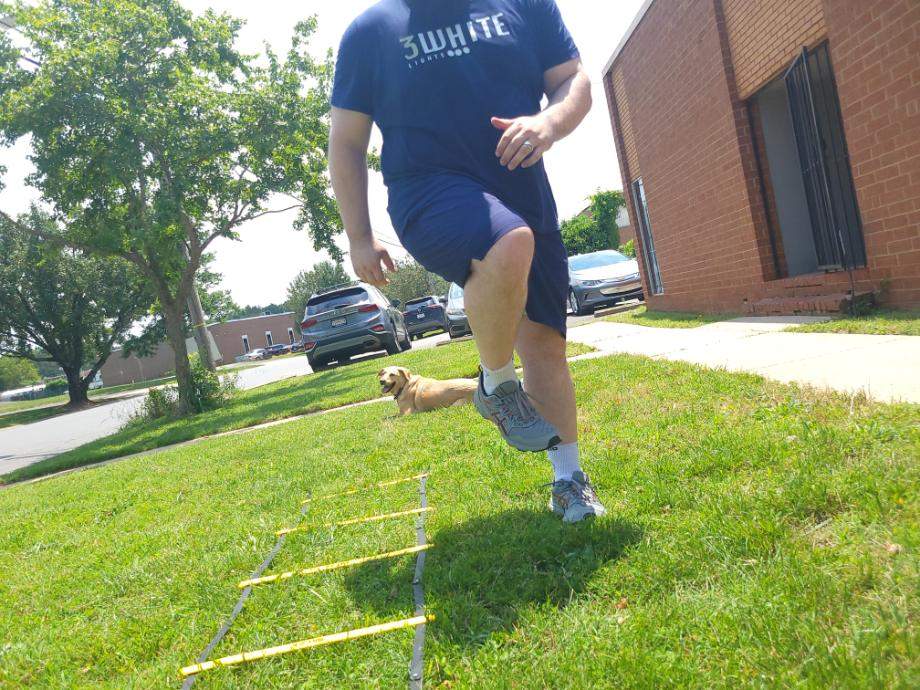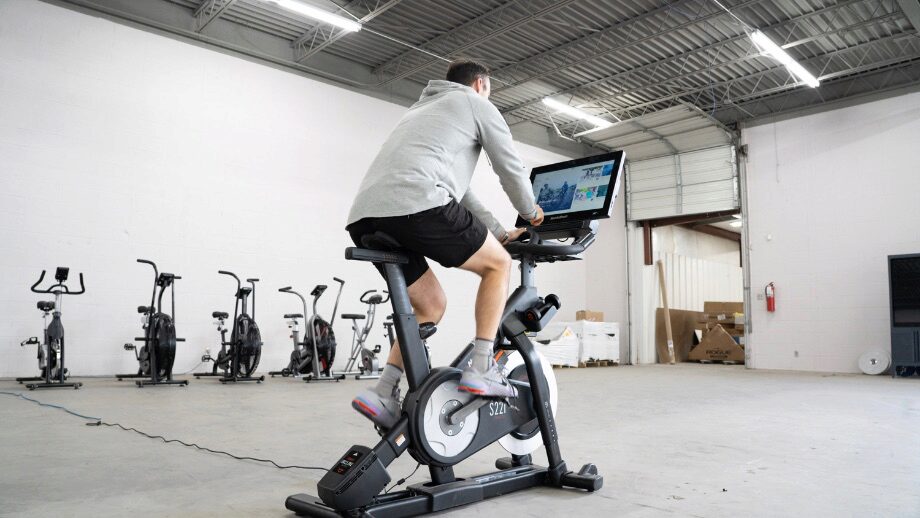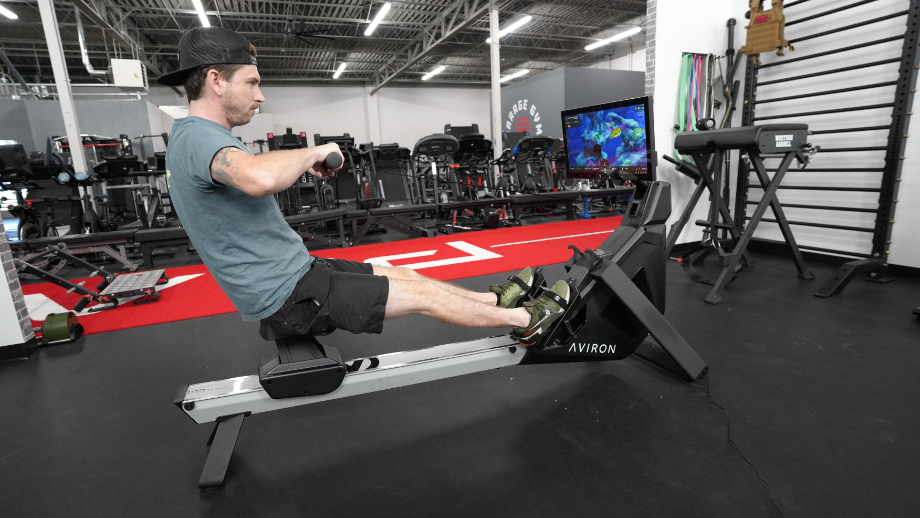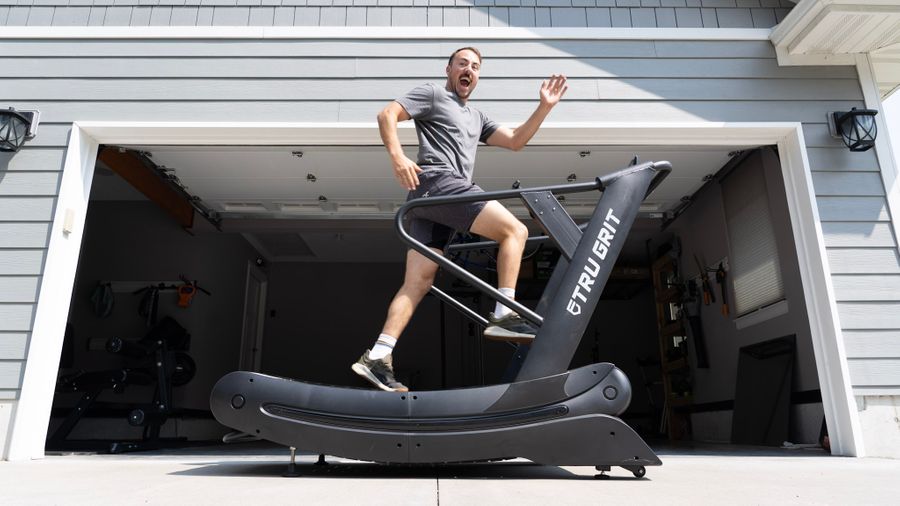From playing and coaching high school football to training for college and men’s rugby to crushing CrossFit and HIIT workouts, I’ve always been able to count on a simple yet effective piece of equipment to consistently deliver results. No, I’m not talking about a barbell or even something as straightforward as a set of the best resistance bands (though they’re also effective).
In my teens, 20s, and (now) 30s, I utilized an agility ladder to help work on my foot speed, quickness, and change-of-direction skills. Plus, as a certified personal trainer (CPT), I’ve called upon this versatile tool to give clients a more dynamic cardio challenge than your typical 30-minute treadmill workout.
RELATED: Best Agility Ladder
While you may think speed ladder drills are only meant for elite athletes, that’s not the case. With a broad spectrum of users ranging from kids to casual gym-goers to pro football players, just about anyone can use an agility ladder to enhance their lateral movement, improve their cardiovascular fitness, or complement their lower-body strength training routine.
Based on my experience as an athlete, coach, and trainer, I’ll show you how to put this affordable piece of fitness equipment to good use with a heart-pumping agility ladder workout that will test your focus as much as your footwork. Although I can’t promise you’ll have fast feet like NFL star Tyreek Hill when you’re done, I can guarantee you’ll feel accomplished when you make it to the end of the ladder one last time.
What Is an Agility Ladder?
There are plenty of strength and conditioning tools to help enhance your athletic performance. While the best plyo boxes can assist with developing explosive jumping power, they don’t exactly offer much in terms of quick changes of direction, lateral movement, or footwork. Neither do weighted vests or slam balls—two other popular pieces of equipment used in athletic training settings.
However, that’s exactly where an agility ladder shines.
Also referred to as a speed ladder, coordination ladder, or simply “ladder” in some circles, it consists of a long, flat ladder with side rails made of fabric, plastic, nylon, or rope with adjustable rungs that allow you to shorten or lengthen the space for your feet to fit in. Cheaper models typically have plastic rungs that slide along the nylon straps. However, they may move during use since they’re not locked.
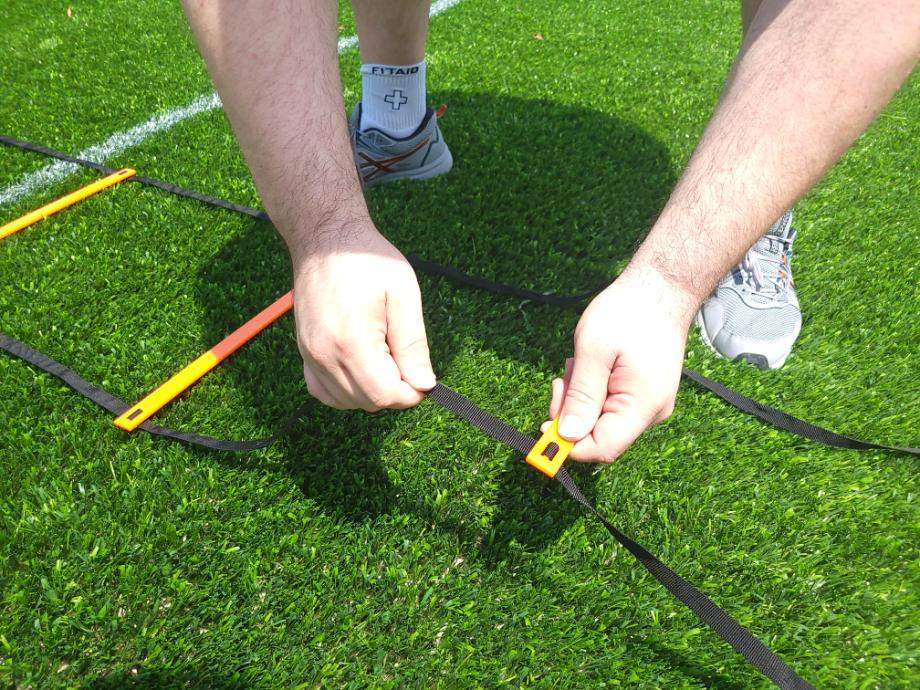
Agility ladders vary in length, number of rungs, material, and, of course, price. Most measure around 20-feet long with at least 10 rungs. Depending on the build materials and overall quality, you can pay as little as $10 or as much as $90 for an agility ladder, making it a fairly budget-friendly addition to your training arsenal.
RELATED: The Best Budget Home Gym Equipment
Sample Agility Ladder Workout
Fortunately, an agility ladder is about as uncomplicated a piece of equipment as you can find. Unfortunately, some of the most popular speed and footwork drills can be challenging to master.
However, don’t let that discourage you from trying this agility ladder workout.
Rather, agility training allows you to enjoy the benefits of Tabata, a form of high-intensity interval training (HIIT). For Tabata training, you’ll typically do eight sets (20 seconds of work followed by 10 seconds of rest) of each exercise. For the workout below, I cut it to six sets to include a few more exercises without making the session too long.
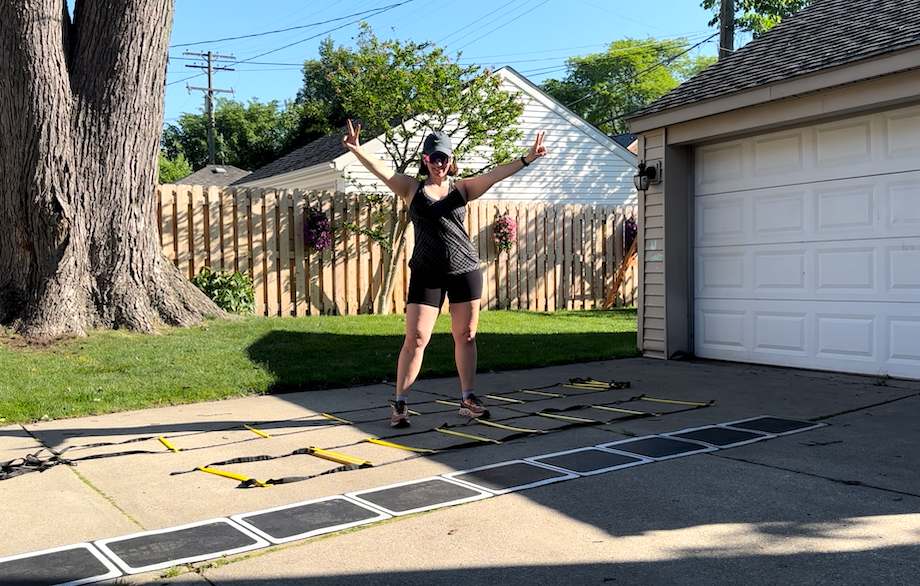
The biggest key is to focus on form over speed, at least in the beginning. Master each movement before you try to blaze through the ladder as quickly as possible. Once you complete all eight sets of one exercise, take a two-minute break, then move on to the next drill.
| Exercise | Instructions | Sets/Reps/Rest |
| One-step | 1. Stand at the beginning of the ladder with your feet about hip-width apart. 2. Run through the ladder with one foot in each box, making sure to keep a slight forward lean with your weight over your toes. 3. Jog back to the beginning and repeat the one-step run for time. | 6 sets of 20 seconds of work, followed by 10 seconds of rest |
| Side-step | 1. Stand at the beginning of the ladder with your body facing sideways. 2. Take a quick lateral step with your lead foot so it lands in the outer half of the first box. 3. Immediately take a lateral step with your outside foot so it lands in the same box. 4. Push off with your back foot and continue side-stepping until you reach the end of the ladder. (Remember to swing your arms in a controlled rhythm.) 5. Repeat facing the opposite direction, alternating sides for time. | 6 sets of 20 seconds of work, followed by 10 seconds of rest |
| Cross-over | 1. Stand to the right side of the ladder. 2. Cross your right foot over your left foot by stepping into the first square. 3. Cross your left foot over your right foot and step to the outside of the ladder. 4. Perform this footwork sequence in alternating fashion down the ladder. 5. Repeat on the other side for time. | 6 sets of 20 seconds of work, followed by 10 seconds of rest |
| Forward Ickey Shuffle | 1. Stand by the side of the first square of the agility ladder, facing the rungs. 2. Step into the first square laterally with your lead foot. 3. Simultaneously lift and place your lead foot outside the first square as you step your second foot into the first square. 4. Place your second foot into the second square, immediately followed by your first foot, then lift and place your second foot outside the second square. 5. Follow this sequence until you reach the end of the ladder. 6. Go back in the opposite direction and repeat for time. | 6 sets of 20 seconds of work, followed by 10 seconds of rest |
| River Dance | 1. Stand by the side of the agility ladder. 2. Step into the first box with your left foot. 3. Take your right foot and step behind and across your left leg. 4. Bring your left leg behind and step your right foot into the second box. 5. Continue this sequence until you reach the end of the ladder. 6. Turn around and move in the opposite direction. | 6 sets of 20 seconds of work, followed by 10 seconds of rest |
| Two In, Two Out (In, In, Out, Out) | 1. Stand outside the first box so you’re perpendicular to the ladder. 2. Step one foot into the first square, immediately followed by your other foot. 3. Step backward with your first foot so it’s outside the box, immediately following with your second foot. 4. Move laterally and repeat in each box until you reach the end of the ladder. 5. Go in the opposite direction and repeat for time. | 6 sets of 20 seconds of work, followed by 10 seconds of rest |
RELATED: Balance Board Workout
Benefits of Agility Ladder Exercises
It’s no secret an agility ladder is designed for explosive speed training. Yet, as much as I love using ladder and cone drills to help athletes become more proficient with their footwork, there are other ways you can benefit from this training tool.
Let’s explore the reasons to lay down a ladder and let your lead leg set the pace for your next cardio workout.
Can Enhance Your Agility and Change-of-Direction
Agility—or the ability to move quickly and easily—is paramount for every athlete, especially those who compete in basketball, football, soccer, tennis, and other sports that require fast change-of-direction abilities. An agility ladder can assist with developing that skill, as you can perform a variety of footwork drills in different directions.
During my college rugby career, we often utilized agility ladders during warm-ups or conditioning days. While a single session didn’t suddenly turn me into a footwork savant, I found consistent use helped me become quicker and more coordinated.
According to a 2022 study in Exercise Science and Kinesiology1 on NCAA Division-II basketball players, ladder training resulted in substantial improvements in stride frequency and ground contact time in both 20-meter sprint and change-of-direction drills. The researchers concluded that agility ladder training may be more effective than conventional training in improving performance and kinematics.
RELATED: Agility Exercises
May Help Support Better Athletic Performance
Increasing your quickness and overall athleticism should set you up for more success on the field, in the gym, or wherever you compete. Anecdotally speaking, I certainly became a more effective rugby player by using an agility ladder to sharpen my footwork and improve my conditioning. For example, I found it easier to move side-to-side on defense, and I was able to evade would-be tacklers more easily as a ball carrier.
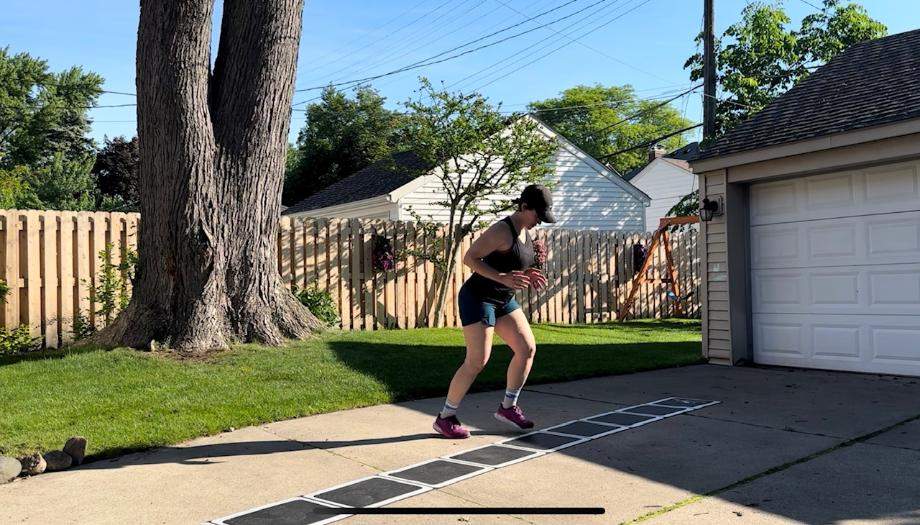
Scientifically, however, there’s no definitive proof that agility ladder training enhances your performance. According to a 2020 systematic review in the International Journal of Sports Medicine2, research is “scarce and problematic” due to poorly described protocols and one-dimensional performance measures.
Can Improve Cardiovascular Health
Any form of cardiovascular exercise will make you a healthier human. Agility ladder training is another option to keep in your toolkit for ramping up your heart rate, burning calories, and improving your conditioning. Including one or two HIIT-style sessions in your workout plan can complement your strength training routine.
RELATED: Benefits of Cardio
May Encourage Better Mental Sharpness
Figuring out how and where you place your feet can be a challenge, especially if you’re trying to keep pace with speedy training partners. However, taking on the task of making it through an agility ladder workout can help you develop better focus and attention to detail. Being careless with your technique will lead to mistakes and an inefficient workout..
Interestingly, a 2023 study3 examining the effects of combining agility ladder training with cognitive training on healthy older adults found that this intervention produced improved muscle power and strength, dynamic balance, agility, and short-term memory. In addition, participants showed improvements in other cognitive functions, including attention and phonological verbal fluency.
RELATED: Exercise and Mental Health
Agility Ladder Training Tips
Poor technique and a lack of concentration can lead to sloppy, inefficient footwork. That’s the opposite of what you want from agility ladder training. With almost two decades of experience relying on this strength and conditioning tool, my expert tips will give you a leg up when it’s time to make your way through the ladder.
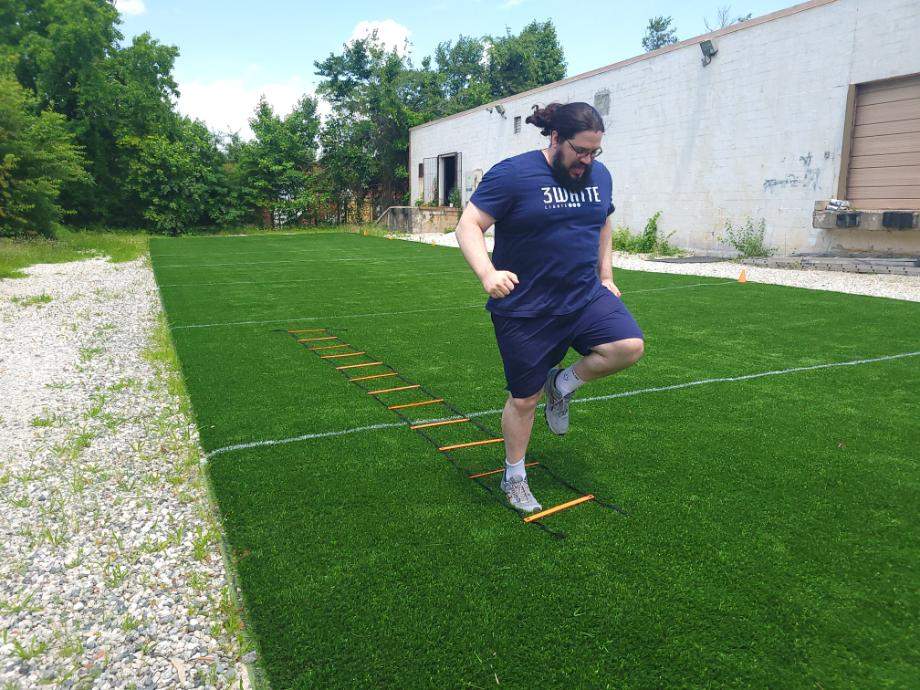
- Be aware of your posture, as it’s easy to look down at your feet, roll your shoulders forward, and forget to engage your core. Keep your head and neck in a neutral position with your shoulders aligned over your hips so your body weight is evenly distributed.
- Stay on the balls of your feet to absorb the impact of landing and allow you to push off with power.
- Start at a manageable pace so you can get accustomed to new footwork drills. There’s no benefit to finishing quicker if you miss half the squares or stumble over the end of the ladder.
- Utilize proper arm movement by pumping them up and down in a controlled rhythm that synchronizes with your footwork.
- Incorporate single-leg exercises like hops and skips to address muscular imbalances or weaknesses.
- Use a weighted vest or ankle weights to add a resistance training element to your agility ladder workout. Even just a few pounds added to your legs can make a major difference in how quickly (or slowly) you move.
RELATED: Best Ankle Weights
Agility Ladder Workout: Final Thoughts
Even if you think you’re past your prime and don’t belong anywhere near an agility ladder, it’s never too late to tap into (and enhance) your natural athletic abilities. Just because you don’t have any aspirations to hit the rugby pitch or play full-court basketball doesn’t mean you can’t benefit from lacing up your favorite cross-training shoes or trusty pair of cleats and putting your entire body to work.
As someone who recently made the transition from competitive athlete to more of your typical #GymRat, I continuously remind myself there’s still a time and a place for traditional strength and conditioning exercises like speed ladder drills. At worst, an agility ladder can provide a more engaging cardio path than an elliptical machine or treadmill.
At best, however, it can transform you into a faster, more agile, and more confident athlete—no matter your age.
Agility Ladder Workout: FAQs
What are some popular agility ladder exercises?
Popular agility ladder exercises include warm-up exercises like high knees and butt kicks and footwork drills like the single-leg hop, single foot in each square, one foot in and one foot out, and the icky shuffle.
Can agility ladder drills improve my balance and coordination?
Yes, agility ladder drills can help enhance your balance and coordination by challenging you to synchronize your lower-body and upper-body movements. Single-leg hops or other unilateral exercises can also help address muscular imbalances.
RELATED: Unilateral Exercises
How often should you do agility training?
As a certified personal trainer (CPT) and longtime rugby player, I recommend doing agility training once or twice per week. Schedule your session on a day when you don’t train your legs to maximize the effectiveness of your change-of-direction and speed drills.
Are the rungs of an agility ladder adjustable?
Yes, you can slide the rungs along the strap of an agility ladder to create more or less space. Smaller gaps will also encourage you to be more precise with your footwork.
References
- Short, T., Ortega, J., Manos, T., Petersen, A., & Sub Kwon, Y. (2022). The Effects of Ladder Training on Sprint and Change of Direction Performance. Exercise Science and Kinesiology, 3(1), 7.
- Afonso, José & Costa, IsraelTeoldo & Camoes, Miguel & Silva, Ana & Lima, Ricardo & Milheiro, André & Martins, Alexandre & Laporta, Lorenzo & Nakamura, Fabio & Clemente, Filipe. (2020). The Effects of Agility Ladders on Performance: A Systematic Review. International Journal of Sports Medicine. 41. 10.1055/a-1157-9078.
- De Lima, V. C., Castaño, L. a. A., Sampaio, R. a. C., Sampaio, P. Y. S., Teixeira, C. V. L., & Uchida, M. C. (2023). Effect of agility ladder training with a cognitive task (dual task) on physical and cognitive functions: a randomized study. Frontiers in Public Health, 11. https://doi.org/10.3389/fpubh.2023.1159343



